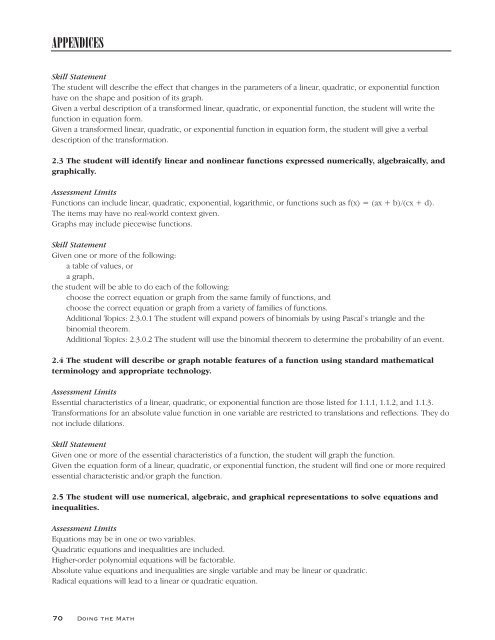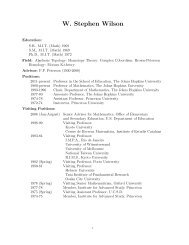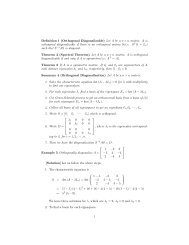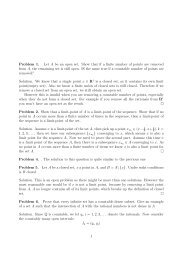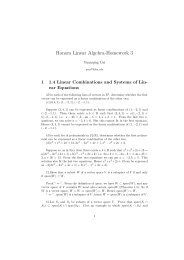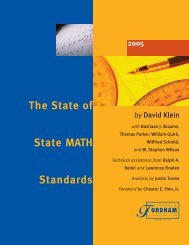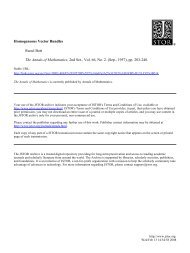Doing the Math - JHU Mathematics - Johns Hopkins University
Doing the Math - JHU Mathematics - Johns Hopkins University
Doing the Math - JHU Mathematics - Johns Hopkins University
You also want an ePaper? Increase the reach of your titles
YUMPU automatically turns print PDFs into web optimized ePapers that Google loves.
APPENDICES<br />
Skill Statement<br />
The student will describe <strong>the</strong> effect that changes in <strong>the</strong> parameters of a linear, quadratic, or exponential function<br />
have on <strong>the</strong> shape and position of its graph.<br />
Given a verbal description of a transformed linear, quadratic, or exponential function, <strong>the</strong> student will write <strong>the</strong><br />
function in equation form.<br />
Given a transformed linear, quadratic, or exponential function in equation form, <strong>the</strong> student will give a verbal<br />
description of <strong>the</strong> transformation.<br />
2.3 The student will identify linear and nonlinear functions expressed numerically, algebraically, and<br />
graphically.<br />
Assessment Limits<br />
Functions can include linear, quadratic, exponential, logarithmic, or functions such as f(x) = (ax + b)/(cx + d).<br />
The items may have no real-world context given.<br />
Graphs may include piecewise functions.<br />
Skill Statement<br />
Given one or more of <strong>the</strong> following:<br />
a table of values, or<br />
a graph,<br />
<strong>the</strong> student will be able to do each of <strong>the</strong> following:<br />
choose <strong>the</strong> correct equation or graph from <strong>the</strong> same family of functions, and<br />
choose <strong>the</strong> correct equation or graph from a variety of families of functions.<br />
Additional Topics: 2.3.0.1 The student will expand powers of binomials by using Pascal’s triangle and <strong>the</strong><br />
binomial <strong>the</strong>orem.<br />
Additional Topics: 2.3.0.2 The student will use <strong>the</strong> binomial <strong>the</strong>orem to determine <strong>the</strong> probability of an event.<br />
2.4 The student will describe or graph notable features of a function using standard ma<strong>the</strong>matical<br />
terminology and appropriate technology.<br />
Assessment Limits<br />
Essential characteristics of a linear, quadratic, or exponential function are those listed for 1.1.1, 1.1.2, and 1.1.3.<br />
Transformations for an absolute value function in one variable are restricted to translations and reflections. They do<br />
not include dilations.<br />
Skill Statement<br />
Given one or more of <strong>the</strong> essential characteristics of a function, <strong>the</strong> student will graph <strong>the</strong> function.<br />
Given <strong>the</strong> equation form of a linear, quadratic, or exponential function, <strong>the</strong> student will find one or more required<br />
essential characteristic and/or graph <strong>the</strong> function.<br />
2.5 The student will use numerical, algebraic, and graphical representations to solve equations and<br />
inequalities.<br />
Assessment Limits<br />
Equations may be in one or two variables.<br />
Quadratic equations and inequalities are included.<br />
Higher-order polynomial equations will be factorable.<br />
Absolute value equations and inequalities are single variable and may be linear or quadratic.<br />
Radical equations will lead to a linear or quadratic equation.<br />
70 <strong>Doing</strong> <strong>the</strong> <strong>Math</strong>


